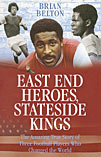 by Brian Belton
by Brian Belton
John Blake, £17.99
Reviewed by David Wangerin
From WSC 256 June 2008
We’ll leave it to West Ham fans to decide whether Ade Coker (nine appearances in three seasons), Clive Charles (14 in four) and Clyde Best (174 in seven) represent the “East End Heroes” of the title. But “Stateside Kings”? If anybody associated with America’s egregious pansy sport even approached the status of a sovereign, they certainly weren’t playing for the Boston Minutemen or the Portland Timbers.
That isn’t to say the three aren’t worthy of scrutiny. Charles, who at Cardiff City became the first black player to captain a Football League team, enjoyed considerable success as an American college coach and took the United States Olympic team to the semi-finals at the 2000 Games in Sydney, their best-ever performance. (He died in 2003.) Coker and Best had decent careers in the NASL, the latter returning to his native Bermuda to manage its ailing national side.
Belton links them by their appearance in the side West Ham fielded on April 1, 1972, the first time three black players had appeared in the same Football League team. A seminal moment in the game’s history? Well, Charles reflects on page 51: “Do you know, I’m not even sure we noticed it.” In fact, neither of the players Belton quotes from (apparently he didn’t bother with Coker) seems particularly struck by the occasion. But what about the struggle against Alf Garnett and his ilk? “I never experienced any racism at Upton Park,” Charles claims. “I just didn’t think of myself as a black soccer player.”
One thus begins to question the point of the book; certainly, after being told that Best “must have thought the world was literally at his feet when he arrived at the Boleyn Ground”, I began to question the wisdom of reading it. Its focus is badly blurred by endless tangential references: the birth of the NASL, reminiscences from celebrity fan Kenny Lynch (“Bobby was the best player I ever saw at West Ham; Trevor Brooking was superb, too…”), even a potted history of Bermuda.
For some reason, Belton includes profiles of Giorgio Chinaglia and Teofilo Cubillas in his chapter on Coker; much of the rest is given over to ex-Hammer Bobby Howe – who, although playing only 11 NASL matches, is deemed one of the “significant pioneers in the development of the American League”.
What we’re left with is a hagiography, one that cries out for a half-decent editor and a better proof-reader. Charles’s role as assistant to Steve Sampson in the US’s ill-fated 1998 World Cup campaign is ignored; instead, the chapter devoted to him is laden with colourless pen-portraits of his proteges (and protegees) and like-a-father-to-me testimonials to the late coach.
Belton has written several books on his team, many along apparently similar lines, but I certainly do not wish to read another. This is not so much a book as a feature article lost in a sea of encyclopaedia entries.